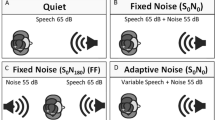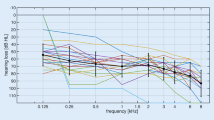Abstract
The objectives of the study were to demonstrate the audiological and subjective benefits of the adaptive UltraZoom beamforming technology available in the Naída CI Q70 sound processor, in cochlear-implanted adults upgraded from a previous generation sound processor. Thirty-four adults aged between 21 and 89 years (mean 53 ± 19) were prospectively included. Nine subjects were unilaterally implanted, 11 bilaterally and 14 were bimodal users. The mean duration of cochlear implant use was 7 years (range 5–15 years). Subjects were tested in quiet with monosyllabic words and in noise with the adaptive French Matrix test in the best-aided conditions. The test setup contained a signal source in front of the subject and three noise sources at +/−90° and 180°. The noise was presented at a fixed level of 65 dB SPL and the level of speech signal was varied to obtain the speech reception threshold (SRT). During the upgrade visit, subjects were tested with the Harmony and with the Naída CI sound processors in omnidirectional microphone configuration. After a take-home phase of 2 months, tests were repeated with the Naída CI processor with and without UltraZoom. Subjective assessment of the sound quality in daily environments was recorded using the APHAB questionnaire. No difference in performance was observed in quiet between the two processors. The Matrix test in noise was possible in the 21 subjects with the better performance. No difference was observed between the two processors for performance in noise when using the omnidirectional microphone. At the follow-up session, the median SRT with the Naída CI processor with UltraZoom was −4 dB compared to −0.45 dB without UltraZoom. The use of UltraZoom improved the median SRT by 3.6 dB (p < 0.0001, Wilcoxon paired test). When looking at the APHAB outcome, improvement was observed for speech understanding in noisy environments (p < 0.01) and in aversive situations (p < 0.05) in the group of 21 subjects who were able to perform the Matrix test in noise and for speech understanding in noise (p < 0.05) in the group of 13 subjects with the poorest performance, who were not able to perform the Matrix test in noise. The use of UltraZoom beamforming technology, available on the new sound processor Naída CI, improves speech performance in difficult and realistic noisy conditions when the cochlear implant user needs to focus on the person speaking at the front. Using the APHAB questionnaire, a subjective benefit for listening in background noise was also observed in subjects with good performance as well as in those with poor performance. This study highlighted the importance of upgrading CI recipients to new technology and to include assessment in noise and subjective feedback evaluation as part of the process.




Similar content being viewed by others
References
Mosnier I, Marx M, Venail F et al (2014) Benefits from upgrade to the CP810 sound processor for Nucleus 24 cochlear implant recipients. Eur Arch Otorhinolaryngol 271:49–57. doi:10.1007/s00405-013-2381-8
Seebens Y, Diller G (2012) Improvements in speech perception after the upgrade from the TEMPO+ to the OPUS 2 audio processor. ORL J Otorhinolaryngol Relat Spec 74:6–11. doi:10.1159/000333124
Schafer EC, Pogue J, Milrany T (2012) List equivalency of the AzBio sentence test in noise for listeners with normal-hearing sensitivity or cochlear implants. J Am Acad Audiol 23:501–509. doi:10.3766/jaaa.23.7.2:10.3766/jaaa.23.7.2
Geißler G, Arweiler I, Hehrmann P et al (2015) Speech reception threshold benefits in cochlear implant users with an adaptive beamformer in real life situations. Cochlear Implant Intern 16:69–76. doi:10.1179/1754762814Y.0000000088
Spriet A, Van Deun L, Eftaxiadis K et al (2007) Speech understanding in background noise with the two-microphone adaptive beamformer BEAM in the nucleus freedom cochlear implant system. Ear Hear 28:62–72. doi:10.1097/01.aud.0000252470.54246.54
Gifford RH, Revit LJ (2010) Speech perception for adult cochlear implant recipients in a realistic background noise: effectiveness of preprocessing strategies and external options for improving speech recognition in noise. J Am Acad Audiol 21:441–451. doi:10.1097/01.aud.0000252470.54246.54
Brockmeyer AM, Potts LG (2011) Evaluation of different signal processing options in unilateral and bilateral cochlear freedom implant recipients using R-Space background noise. J Am Acad Audiol 22:65–80. doi:10.3766/jaaa.22.2.2
Hersbach AA, Arora K, Mauger SJ et al (2012) Combining directional microphone and single-channel noise reduction algorithms: a clinical evaluation in difficult listening conditions with cochlear implant users. Ear Hear 33:e13–e23. doi:10.1097/AUD.0b013e31824b9e21
Buechner A, Dyballa KH, Hehrmann P, Fredelake S, Lenarz T (2014) Advanced beamformers for cochlear implant users: acute measurement of speech perception in challenging listening conditions. PLoS One 9(4):e95542
Peterson PM, Wie SM, Rabinowitz WM et al (1990) Robustness of an adaptive beamforming method for hearing aids. Acta Otolaryngol Suppl 469:85–90
Greenberg JE, Zurek PM (1992) Evaluation of an adaptive beamforming method for hearing aids. J Acoust Soc Am 91:1662–1676
Kompis M, Dillier N (2001) Performance of an adaptive beamforming noise reduction scheme for hearing aid applications. II. Experimental verification of the predictions. J Acoust Soc Am 109:1134–1143
Cox RM, Alexander GC (1995) The abbreviated profile of hearing aid benefit. Ear Hear 16:176–186
Büchner A, Brendel M, Saalfeld H et al (2010) Results of a pilot study with a signal enhancement algorithm for HiRes120 cochlear implant users. Otol Neurotol 31:1386–1390. doi:10.1097/MAO.0b013e3181f1cdc6
Kolberg E, Sheffield SW, Davis TJ et al (2015) Cochlear implant microphone location affects speech recognition in diffuse noise. J Am Acad Audiol 26:51–58. doi:10.3766/jaaa.26.1.6
Jansen S, Luts H, Wagener KC et al (2012) Comparison of three types of French speech-in-noise tests: a multi-center study. Int J Audiol 51:164–173. doi:10.3109/14992027.2011.633568
Wagener KC, Kuehnel V, Kollmeier B (1999) Entwicklung und Evaluation eines Satztests für die deutsche Sprache I: design des Oldenburger Satztests. Zeitschrift für Audiologie 38:44–56
Thornton AR, Raffin MJ (1978) Speech-discrimination scores modeled as a binomial variable. J Speech Hear Res 21(3):507–518
McCreery RW, Venediktov RA, Coleman JJ et al (2012) An evidence-based systematic review of directional microphones and digital noise reduction hearing aids in school-age children with hearing loss. Am J Audiol 21:295–312. doi:10.1044/1059-0889(2012/12-0014)
Reference Notes
Nyffeler M (2010) StereoZoom, improvements with directional microphones. Field study News Phonak AG, Switzerland
Advanced Bionics (2015) Advanced Bionics technologies for understanding speech in noise. White paper
Acknowledgments
The authors gratefully acknowledge Solange Lator who collected the data.
Author information
Authors and Affiliations
Contributions
IM is the main researcher, who designed the experiments, analyzed data and wrote the paper. JF, DA, AL, SB, EAD, and MD performed the experiments. NM provided writing assistance. DB and OS provided critical revision. All authors discussed the results and implications and commented on the manuscript at all stages.
Corresponding author
Ethics declarations
Conflict of interest
One of the authors (NM) is an employee of Advanced Bionics. Other authors declare they have no conflict of interest.
Ethical approval
All procedures performed in studies involving human participants were in accordance with the ethical standards of the institutional and/or national research committee and with the 1964 Helsinki Declaration and its later amendments or comparable ethical standards.
Informed consent
Informed consent was obtained from all individual participants included in the study.
Ethical standards
Ethics approval was given by the French ethical committee: ‘Comité de Protection des Personnes – Ile-de-France VI’. Subjects obtained no reward or personal gain from taking part in the study. The study was conducted in accordance with the Declaration of Helsinki and followed Good Clinical Practice Guidelines.
Rights and permissions
About this article
Cite this article
Mosnier, I., Mathias, N., Flament, J. et al. Benefit of the UltraZoom beamforming technology in noise in cochlear implant users. Eur Arch Otorhinolaryngol 274, 3335–3342 (2017). https://doi.org/10.1007/s00405-017-4651-3
Received:
Accepted:
Published:
Issue Date:
DOI: https://doi.org/10.1007/s00405-017-4651-3




